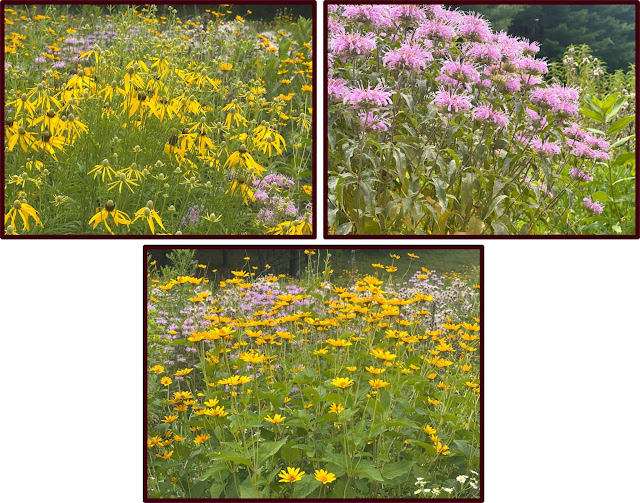Article written by Madeline Wimmer - Extension Educator, Fruit Production

Below are some points to consider when thinking about installing pollinator-friendly habitat:
If you’re at the early stages of planning a pollinator habitat installation, taking some time to create a vision and practical goals specific to your farm is a good starting point.
The University of Minnesota recently published a short guide that helps you do this as you get ready to determine pre-planting aspects like cost-share resources and programs for funding, plant selection, and considerations for site preparation.
Create space for some unstructured time, make a cup of something warm, and step into your planning brain—you’ll want to think creatively as well as practically during this process.
UMN pollinator management plan: https://z.umn.edu/pollinator_plan
Images: Pollinator resources often recommend planting at least three species of pollinator friendly plants, specific to your crop and region, for each bloom period (early, mid-season, late).
Introduction
Successful pollination is key for quality fruit production anywhere in the world. When the fruit set is lower than expected, there are a number of factors that could be contributing, depending on which fruit crop you’re growing, including the following:- Very few fruit crops, like grapes, are wind pollinated, but the majority of fruit crops rely on, or benefit from insect pollination (primarily bees).
- Some fruit crops are self-incompatible, which means they will not use their own pollen for pollination. Two varieties used to cross pollinate one another need their bloom times to overlap.
- Additionally...
- Certain fruit crops, like honeyberries, are self-incompatible and will not accept pollen from varieties that are too closely related to them.
- Very few fruit crops, like kiwiberries have male flowers on one plant and females on another (dioecious).
- A handful of grape varieties (e.g., St. Pepin) are functionally female, both crops requiring care to have enough pollinizers (male grapevines or pollen producing variety) to support the pollination process.
- In general, successful insect pollination relates to how many pollinators are present during bloom, along with weather conditions, and availability of resources.
Pollinator-friendly habitat installations
This is where creating a pollinator habitat installation can be extremely beneficial, keeping in mind that pollinators need resources like food and water, along with a place to nest.There are a number of programs out there that can support growers who are looking to install pollinator habitat. A good place to start is on the Minnesota Department of Agriculture’s webpage: Pollinator toolbox: Identifying programs and funding.
Below are some points to consider when thinking about installing pollinator-friendly habitat:
- Similar to any other perennial crop, planting pollinator habitats is an active process that requires planning related to site selection, site preparation (i.e., general nutrient profile and weed pre-planting management), and care for establishment and maintenance.
- Pollinator plants should be compatible with specific pollinators on site and cover dry parts of the season when crops are not in bloom.
- A list of pollinator plants suitable for the Upper Midwest can be found online, including the Xerces publication: Native plants for pollinators and beneficial insects: Great Lakes region, and Native Plants for Pollinators and Beneficial Insects: Northern Plains Region.
- It is generally recommended to install three different types of pollinator species for each bloom period (e.g., early-, mid-, and late-blooming).
- Other considerations may relate to whether you choose to plant native or non-native plants, seeds vs plugs, or transplants, and the planting location's risk to pesticide drift and other risks.
- Cover crops and certain weedy plant species can also provide resources for pollinators and should be considered when thinking about a pollinator management plan. They can provide benefits, but can also become a trap crop during pesticide applications, causing unintended exposure.
New: UMN pollinator planning guide for fruit growers
Image: The first and last page of the UMN Pollinator management plan outlaying the purpose of planning and the various aspects that can help guide readers through the planning process.
The University of Minnesota recently published a short guide that helps you do this as you get ready to determine pre-planting aspects like cost-share resources and programs for funding, plant selection, and considerations for site preparation.
Create space for some unstructured time, make a cup of something warm, and step into your planning brain—you’ll want to think creatively as well as practically during this process.
UMN pollinator management plan: https://z.umn.edu/pollinator_plan

Comments
Post a Comment